new posts in all blogs
Viewing: Blog Posts Tagged with: sophie blackall, Most Recent at Top [Help]
Results 1 - 25 of 50
How to use this Page
You are viewing the most recent posts tagged with the words: sophie blackall in the JacketFlap blog reader. What is a tag? Think of a tag as a keyword or category label. Tags can both help you find posts on JacketFlap.com as well as provide an easy way for you to "remember" and classify posts for later recall. Try adding a tag yourself by clicking "Add a tag" below a post's header. Scroll down through the list of Recent Posts in the left column and click on a post title that sounds interesting. You can view all posts from a specific blog by clicking the Blog name in the right column, or you can click a 'More Posts from this Blog' link in any individual post.

By:
Betsy Bird,
on 11/6/2016
Blog:
A Fuse #8 Production
(
Login to Add to MyJacketFlap)
JacketFlap tags:
Ursula Vernon,
Leila Sales,
Christine Mari Inzer,
Alison DeCamp,
Funny Girl,
Adrianne Chalepah,
Akilah Hughes,
Delaney Yeager,
Mackenzie Yeager,
Shannon Hale,
Sophie Blackall,
Write Girl,
Rita Williams-Garcia,
Libba Bray,
Uncategorized,
Mitali Perkins,
Lisa Graff,
Cece Bell,
Lenore Look,
Charise Mericle Harper,
Carmen Agra Deedy,
Jenni Holm,
Raina Telgemeier,
Meghan McCarthy,
Deborah Underwood,
Lisa Brown,
Kelly DiPucchio,
Amy Ignatow,
Add a tag
Ladies and gentlemen . . . the moment I’ve been waiting for.
Wait! Wait! Background information first!
So for years I worked as a children’s librarian and I’d get girl after girl after girl coming up to my desk asking for funny books. I credit some of this to Diary of a Wimpy Kid. The boys and the girls loved that series and wanted more of the same. Sometimes they wanted it in a notebook novel format, like Kinney’s book. Sometimes they just wanted something hilarious, and they seriously didn’t care who wrote it. So I’d grab books for them and then it slowly began to dawn on me. Huh. For all that I could find some pretty fantastic and hilarious books out there for kids, where were the funny story collections written by women? Turns out, there weren’t any.
Until now.
I would like you to join me in applauding the following authors and author/illustrators . . . .
- Cece Bell
- Sophie Blackall
- Libba Bray
- Lisa Brown
- Adrianne Chalepah
- Alison DeCamp
- Carmen Agra Deedy
- Kelly DiPucchio
- Lisa Graff
- Shannon Hale
- Charise Mericle Harper
- Jenni Holm
- Akilah Hughes
- Amy Ignatow
- Christine Mari Inzer
- Lenore Look
- Meghan McCarthy
- Mitali Perkins
- Leila Sales
- Raina Telgemeier
- Deborah Underwood
- Ursula Vernon
- Rita Williams-Garcia
- Delaney Yeager
- and Mackenzie Yeager
Each one of these women has contributed to my new book Funny Girl: Funniest. Stories. EVER.
Behold! The cover by the aforementioned Charise Mericle Harper:

And here’s the full jacket in its entirety:

A portion of the proceeds of this book go to Write Girl, a Los Angeles-based creative writing and mentoring organization that matches girls with women writers who mentor them in creative writing.
When’s it out? May 9th, 2017! Feel free to pre-order it.
Oh! And while I’m thinking of it, there’s this other really fun thing that just started that I have to let you know about. As I may have mentioned before, my husband’s first book The Secrets of Story just came out recently and I could be prouder. He’s already put up a couple great videos alongside it (the latest is here and is about those little moments of humanity that make you like a character). But fun upon fun upon fun, he’s created a podcast with YA author and 90-Second Newbery Film Festival creator James Kennedy and it may well be my favorite thing of all time. I love it when James and Matt get together because they agree on NOTHING! And now they’ve a podcast together where they can extol the beauty of that nothing together. It’s huge fun for me, and it ends with a little feature where they mention a story idea they had that they decided wouldn’t work and give it away (as it were) to the masses for use. So if you like the process of writing or you just like banter, I’ve your new favorite podcast. The Secrets of Storytelling podcast is available through iTunes. Subscribe today!

Unless you missed it, recently the New York Times Best Illustrated list was released. And amongst the ten books listed was a very lovely title illustrated by Ms. Sophie Blackall and called A Voyage in the Clouds: The (Mostly) True Story of the First International Flight by Balloon in 1785. Written by Matthew Olshan it has it all. Jealousy. Foul play. Public urination. The works!
To celebrate the book’s inclusion on the list, we’re doing a bit of a giveaway. A giveaway where you can actually win a piece of Sophie Blackall art of your very own. THIS art:

What do you need to do? It’s easy! Sophie had an idea to get out the vote in a small way of her own. Just share here in the comment section of this post your preferred mode of transportation you will use to get to the polls on Tuesday. By air, by land, by sea, you name it. The sillier, the better
Submit your suggestions by the end of Tuesday. You’ll be getting out the vote and potentially winning gorgeous art. It’s win-win!


Naturally you know what tomorrow is.
You don’t? Doggone calendars. You’d think they’d have the wherewithal to remember that October 21st is Ivy & Bean Day. And now here’s the interesting part. You heard it here first, folks, but Ivy & Bean are going to have . . . AN ELEVENTH BOOK!!
Don’t believe me? Hear it from Ms. Annie Barrows herself:
 When I finished Ivy and Bean Take the Case, the tenth book in the series, I figured it was time to take a break from my girls. Why? Because ten books are a lot. Ten books are bigger than my head. Ten books are really heavy. Ten books are enough. Besides, I was writing a novel for grownups. I was busy.
When I finished Ivy and Bean Take the Case, the tenth book in the series, I figured it was time to take a break from my girls. Why? Because ten books are a lot. Ten books are bigger than my head. Ten books are really heavy. Ten books are enough. Besides, I was writing a novel for grownups. I was busy.
When my novel came out and I toured for it, I couldn’t help noticing that grownup audiences are incredibly well-behaved. No one falls out of her chair. No one pulls his neighbor’s hair. No one cries. No one has to go to the bathroom right now. No one asks me how old I am. But also: no one asks me what my favorite color is. No one wants to hear interesting facts about being eaten by squids. No one laughs so hard she has to go to the bathroom right now.
I missed kids.
One day when I was sick of the thing I was supposed to be working on, I wrote a scene about Ivy and Bean and one of those weird dolls that’s supposed to look like a real baby. I laughed and put it away. A little while later, I wrote another scene, about quicksand this time. I laughed some more. Eventually, it occurred to me that
(a) I was having fun
(b) I missed little kids
(c) A lot of readers wanted another Ivy and Bean book
(d) Why didn’t I just go ahead and write one?
So I did.
Sophie Blackall had her own two cents to add.
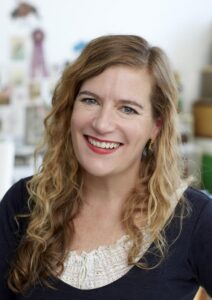 The number one question I get asked in school visits is, ‘WHEN will there be a new Ivy and Bean???’ For years, I have left behind a trail of frustrated second graders, shaking their collective fists. Finally I’ll be able to hold my head high and say, ‘Soon, my friends. SOON.’ You have no idea what a relief this will be. Plus I get to work with Annie and Victoria again. Which is so much fun it isn’t really work at all.
The number one question I get asked in school visits is, ‘WHEN will there be a new Ivy and Bean???’ For years, I have left behind a trail of frustrated second graders, shaking their collective fists. Finally I’ll be able to hold my head high and say, ‘Soon, my friends. SOON.’ You have no idea what a relief this will be. Plus I get to work with Annie and Victoria again. Which is so much fun it isn’t really work at all.
In the meantime, Ivy and Bean haven’t just been lying around eating candy. They are hard at work advocating for vaccination against measles and will be appearing in a hilarious (and informative) comic book, in association with The American Academy of Pediatrics and The Measles and Rubella Initiative. 375,000 copies of the books, Ivy and Bean vs. The Measles will be distributed to doctors’ offices across the country this Fall in English and Spanish language editions!
This is, insofar as I can tell, big news. I have never, ever seen a publisher with the guts to take on immunization. I mean, check out these posters:


So there you have it folks. A new Ivy & Bean on the horizon and a very worthy cause. Not too shabby for a Friday, eh?

 |
| Sophie at the Gates Foundation with her artwork for the Measles and Rubella Initiative because she's so effing amazing. http://measlesrubellainitiative.org/sophie-blackall/ |
While there is nothing like hearing
Sophie Blackall speak in person — and seeing the treasure trove of images that make up her slideshows — you can get a bit of a taste of this morning's speech by reading her Caldecott acceptance speech so kindly available online at
The Horn Book.
Sophie also shares some photos of the installation of her collections she put together for Brooklyn Public Library, an installation that is as wild and fascinating as anything you'd find at the Natural Museum of History (both Sophie's installation and the American Museum of Natural History have penguins, but
Sophie's wears a top hat).
REALLY, if you're not here today to hear Sophie, the best thing you can do is go buy all of Sophie's thirty or so books, immediately.And also read her excellent blog, which tells in depth the making-of stories behind many of her books, including
Finding Winnie as well as posts about her time in places like
Rwanda or the DRC, where she was lucky enough to meet amazing kids and families.
Sophie ends with an Annie Dillard quote:
One of the things I know about writing is this: spend it all, shoot it, play it, lose it, all, right away, every time. Do not hoard what seems good for a later place in the book or for another book; give it, give it all, give it now. The impulse to save something good for a better place later is the signal to spend it now. Something more will arise for later, something better. These things fill from behind, from beneath, like well water. Similarly, the impulse to keep to yourself what you have learned is not only shameful, it is destructive. Anything you do not give freely and abundantly becomes lost to you. You open your safe and find ashes.
By:
Sue Morris @ KidLitReviews,
on 3/9/2016
Blog:
Kid Lit Reviews
(
Login to Add to MyJacketFlap)
JacketFlap tags:
Harry Colebourn,
Library Donated Books,
Lindsay Mattick,
5-Stars,
Finding Winnie: The True Story of the World’s Most Famous Bear,
Children's Books,
Picture Books,
NonFiction,
bears,
Winnie-the-Pooh,
World War I,
Sophie Blackall,
Debut Author,
Hachette Book Group,
Little,
Brown and Company,
Add a tag
Finding Winnie: The True Story of the World’s Most Famous Bear Written by Lindsay Mattick Illustrated by Sophie Blackall Little, Brown and Company 10/20/2015 978-0-316-32490-8 32 pages Ages 4—8 . . “Before Winnie-the-Pooh, there was a real bear named Winnie. In 1914, Harry Colebourn, a veterinarian on his way to tend horses in World …

By:
Betsy Bird,
on 3/5/2016
Blog:
A Fuse #8 Production
(
Login to Add to MyJacketFlap)
JacketFlap tags:
Dr. Seuss,
Videos,
book trailers,
Lois Lowry,
Suzy Lee,
Library of Congress,
Sophie Blackall,
Red Nose Studio,
Video Sunday,
Back to the Future,
author videos,
Hans Christian Andersen Award,
Add a tag
Ack! Too many good videos, too little time! We’ve an embarrassment of riches today. The only question really is where to start. And the only natural answer is with Obama’s nominee for the Librarian of Congress. Not much of a question there, really.
Next up, there is beginning to be a bit of a tradition of authors and illustrators recording videos of how they got “the call” when they won the Caldecott or Newbery (I almost wrote and/or Newbery, which is an interesting near flub). Last year we had Dan Santat’s video. This year, Sophie Blackall’s:
At this rate it may behoove us to just give the medals to people who are good at making videos. And the Newbery Medal goes to . . . Tyler Oakley!
Now let’s get down to brass tacks. People, there are awards out there that go beyond the mere borders of this great nation of ours. And the Hans Christian Andersen Award is the greatest of these (though the Astrid Lindgren Award gives it a run for its money). Now they’ve made a video for us that goes through the 2016 nominees. I adore this. I just want to meet all these people. Suzy Lee!!! Now, weirdly, I want her to adopt me. And Iran! How cool is that?
This next book trailer seemingly has an international flavor to it, but is homegrown Americana through and through. It may also be the most beautiful trailer of 2016 thus far.
Thanks to educating alice for the link.
Earlier this week, Phil Nel posted a killer post called Seuss on Film. The piece is “a brief (but far from complete) collection of Seuss on film!” Turns out, it was somewhat tricky getting Mr. Geisel on the old camera. Phil’s a trooper, though. He found newsreel after newsreel and has posted them on YouTube for our collective enjoyment. You should really read his posting yourself. In fact, I insist upon it. And just to whet your whistle, here’s a jaw-dropping 1964 discussion with Seuss in New Zealand where he improvises answers to kids’ questions.
As for our Off-Topic Video of the week, I give this to you because I love you. Really, truly, deeply love you.
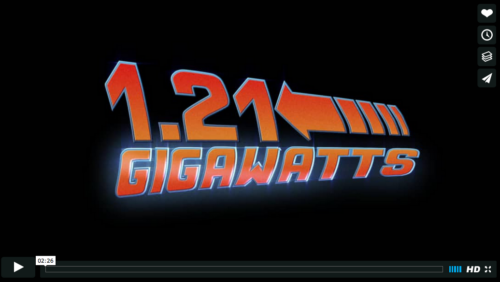


By: Jessica Lanan,
on 2/26/2016
Blog:
Jessica Lanan Illustration
(
Login to Add to MyJacketFlap)
JacketFlap tags:
SCBWI,
Blog,
NY,
New York,
Conference,
William Joyce,
Sophie Blackall,
Gary Schmidt,
Rita Williams-Garcia,
News and Events,
Add a tag
I’m finally sifting through all my notes and experiences from my trip to New York. It was a cold weekend to be in the big apple, with temperatures outside hovering in the single digits. Despite the frigid weather we were warm and safe inside the hotel, surrounded by a star-studded faculty of kidlit experts. Here are just a few of the highlights:

From the sketchbook
Two-time Newberry Honor winner Gary Schmidt made everyone cry about five different times during his moving keynote about the importance of writing for kids. He emphasized that writing should be an expression of empathy and compassion: we must “show up” instead of leaving the reader behind. I can’t do Mr. Schmidt justice, so I’ll just encourage you to read all of his heartrending books and leave you with a quote:
“Writing should be an act of empathy in a broken world. What ails you? That is the question we ask.” – Gary Schmidt, author
If you’ve ever submitted a manuscript exactly one time and, upon receiving a rejection letter, decided to give up: William Joyce, Oscar winner and acclaimed writer and illustrator of dozens of books, received over 250 rejection letters at the beginning of his career. So maybe it wouldn’t hurt to keep revising and try again. He also offered this advice to illustrators on finding your voice:
“Find the artists you love, find out what you love about them, and then… steal.” -William Joyce, author/illustrator and filmmaker

William Joyce speaking at SCBWI NY 2016
Newberry Honor and Coretta Scott King award-winner Rita Williams-Garcia made everyone laugh during her keynote about the “Dos and Don’ts” of writing. Her witty anecdotes shed light on the hard-earned successes and naive missteps along the road to publication.
“Do live with gratitude. Do live in the plan. Do what you’re doing.” – Rita Williams-Garcia
The delightful Sophie Blackall inspired everyone with the story of how her personal project to illustrate the Missed Connections column on Craigslist helped to jump-started her career. She also shared stories and photos from her travels working with Save the Children and other humanitarian organizations, and gave us a fascinating behind-the-scenes look at all the research and love that went into this year’s Caldecott winner, Finding Winnie. She signed my copy of book and even drew a little sketch in it!
“Do that thing that’s just for yourself, because it’s almost always your best work.” -Sophie Blackall, author and illustrator

Getting my book signed.
The conference also featured several panels representing editors, art directors, publishers and agents who offered a broad perspective on the state of the industry. There was a lot of encouraging news about the health of children’s literature and plenty of sage advice for aspiring authors and illustrators. Here are a few quotes that stood out:
“You’re only as good as the people you work with.” – David Saylor, Creative Director at Scholastic
“Don’t take shortcuts. If you put everything you have in [your work], you can’t fail.” – Holly McGhee, Agent at Pippin Properties
“You have something that no one else has, and your job is to figure out what that is.” -Cecilia Yung, VP and Art Director at Penguin Random House
“Know your competition. […] Your competition is everything kids are doing other than reading books.” – Andrea Pappenheimer, Director of Sales at HarperCollins

By: JOANNA MARPLE,
on 2/2/2016
Blog:
Miss Marple's Musings
(
Login to Add to MyJacketFlap)
JacketFlap tags:
Interview,
picture book,
picture books,
Illustrators,
Sophie Blackall,
Illustrator interview,
Kelly Murphy,
Melissa Sweet.,
Jennifer Theremes,
studio cats,
Add a tag
I have been following Jen for quite a while now on social media and as I am a huge Darwin fan, I wanted to highlight her on my blog before her next picture book comes out!
[JM] Illustrator or author/illustrator? If … Continue reading →
 We’ve collected the books debuting on Indiebound’s Indie Bestseller List for the week ending Jan. 17, 2016–a sneak peek at the books everybody will be talking about next month.
We’ve collected the books debuting on Indiebound’s Indie Bestseller List for the week ending Jan. 17, 2016–a sneak peek at the books everybody will be talking about next month.
(Debuted at #1 in Children’s Illustrated) Finding Winnie: The True Story of the World’s Most Famous Bear written by Lindsay Mattick and illustrated by Sophie Blackall: “Before Winnie-the-Pooh, there was a real bear named Winnie. And she was a girl! In 1914, Harry Colebourn, a veterinarian on his way to tend horses in World War I, followed his heart and rescued a baby bear. He named her Winnie, after his hometown of Winnipeg, and he took the bear to war.” (Oct. 2015)
(Debuted at #2 in Children’s Illustrated) Last Stop on Market Street written by Matt de la Peña and illustrated by Christian Robinson: “Every Sunday after church, CJ and his grandma ride the bus across town. But today, CJ wonders why they don’t own a car like his friend Colby. Why doesn’t he have an iPod like the boys on the bus? How come they always have to get off in the dirty part of town?” (Jan. 2015)
(Debuted at #7 in Hardcover Nonfiction) The Name of God Is Mercy by Pope Francis: “In this conversation with Vatican reporter Andrea Tornielli, Francis explains—through memories from his youth and moving anecdotes from his experiences as a pastor—why ‘mercy is the first attribute of God.'” (Jan. 2016)

By: Maryann Yin,
on 1/11/2016
Blog:
Galley Cat (Mediabistro)
(
Login to Add to MyJacketFlap)
JacketFlap tags:
Laura Ruby,
Sophie Blackall,
Pam Muñoz Ryan,
Matt de la Peña,
Christian Robinson,
Becky Albertalli,
Awards,
Publishing,
David Levithan,
Add a tag
 The American Library Association has announced that Last Stop on Market Street author Matt de la Peña is the winner of the prestigious John Newbery Medal. Throughout his career, de la Peña has written 6 young adult novels, 2 middle grade novels, and 2 picture books.
The American Library Association has announced that Last Stop on Market Street author Matt de la Peña is the winner of the prestigious John Newbery Medal. Throughout his career, de la Peña has written 6 young adult novels, 2 middle grade novels, and 2 picture books.
Last Stop on Market Street features illustrations created by Christian Robinson. Robinson earned a Caldecott Honor for this picture book.
We’ve linked to free samples of the Newbery Medal-winning title and the Newbery Honor books below. In addition to the newest winner of the Newbery Medal, the organization has also revealed that Finding Winnie illustrator Sophie Blackall has won the Randolph Caldecott Medal, Bone Gap author Laura Ruby has won the Michael L. Printz Award, Simon vs. The Homo Sapiens Agenda author Becky Albertalli has won the William C. Morris Award, and Boy Meets Boy author David Levithan has won the Margaret A. Edwards Award. Follow this link to access free samples from last year’s pool of Youth Media Award winners.
Free Samples of the ALA Youth Media Award Recognized Books
Newbery Medal Winner
Last Stop on Market Street written by Matt de la Peña and illustrated by Christian Robinson
Newbery Honor Winners
The War That Saved My Life by Kimberly Brubaker Bradley
Roller Girl written and illustrated by Victoria Jamieson
Echo by Pam Muñoz Ryan
This has been quite the year in children's literature--and I say that in a good way. Some people are decrying social media, but I celebrate it. It is making a difference.
Some say social media that questions books like A Fine Dessert is unfairly attacking the author and illustrator. Some say the creators of the book are being publicly shamed. Roger Sutton said that about the change made to Amazing Grace.
But you know who has been publicly shamed
for decades and decades?
Children.
Children whose culture is misrepresented or poorly
represented in popular, classic, and award-winning books.
In his new book,
Poet: The Remarkable Story of George Moses Horton, Don Tate's note in the back is important. He writes:
When I first began illustrating children's books, I decided that I would not work on stories about slavery. I had many reasons, one being that I wanted to focus on contemporary stories relevant to young readers today. In all honesty, though, what I wasn't admitting to myself was that I was ashamed of the topic.
I grew up in a small town in the Midwest in the 1970s and 1980s. At school, I was usually the only brown face in a sea of white. It seemed to me that whenever the topic of black history came up, it was always in relation to slavery, about how black people were once the property of white people--no more human than a horse or a wheelbarrow. Sometimes white kids snickered and made jokes about the topic. Sometimes, black kids did too.
A wash of emotion floods over me each time I read Don's words. I've heard similar things from Native kids and teens, too. Don takes up the topic of slavery in
Poet. But he does it with a full understanding of what it feels like to be a black child reading a book that depicts slavery.
I have no doubt that Emily Jenkins and Sophie Blackall meant well when they created
A Fine Dessert, but they and the community of people who worked with them on the book created it from within a space that doesn't have what Don has. The outcome, as most of us know, has caused an enormous discussion on social media.
I have empathy for Jenkins and Blackall, but as my larger text above makes clear, my empathy is with children. Because of social media, Jenkins, Blackall, and anyone who is following this discussion, have heard from people they don't normally hear from. People who aren't in their community. In this case, African American parents who are stunned with the depiction of slavery in
A Fine Dessert. Some of the response has been blistering in its anger. Jenkins has heard them, and subsequently, apologized.
Thus far, Blackall has not. She says she's heard them, but what does it mean when you hear someone--with reason or with fury--tell you that you've hurt them, but all you do is rebut what they say? I don't know what to call that response.
She and people who are empathizing with her are decrying social media, but I celebrate what it is doing right now in children's literature. Because of it, I have a blog that people read. They link to it. They reference it. They assign it. They share it. The outcome? People write to tell me what they're learning.
Because of social media, we can all watch a video of a panel discussion that took place last weekend. A discussion--I think--that has never happened before at a conference. I'm asking my colleagues who research children's literature. Nobody recalls one like this before.
Sean Qualls, Sophie Blackall, and Daniel Jose Older spoke on a panel titled "Lens of Diversity: It is Not All in What You See" at the New York City School Library System's 26th annual conference. I'm studying the video and will have more to say about it later, but for now, watch it yourself.
I'll be back with a post about it later. For now I've got to finish preparing a talk I'll be giving for Chicago Public Library tomorrow. I was shaken to the core as I watched the video. Shaken by the denial of Qualls and Blackall, and shaken by the honesty of Older. He is using social media to effect change. Change is happening. I know that change is happening because of the email I get from gatekeepers.
I think we're in the crisis that Walter Dean Myers anticipated in 1986 in his
New York Times article,
I Thought We Would Actually Revolutionize the Industry. He wrote about how the 1970s looked like a turning point:
...the quality of the books written by blacks in the 70's was so outstanding that I actually thought we would revolutionize the industry, bringing to it a quality and dimension that would raise the standard for all children's books. Wrong. Wrong. Wrong. No sooner had all the pieces conducive to the publishing of more books on the black experience come together than they started falling apart.
This time round, I think things will not fall apart. Social media is driving change in children's literature. And so, I celebrate it.
Some months ago, a reader asked me if I'd seen A Fine Dessert: Four Centuries, Four Families, One Delicious Treat written by Emily Jenkins, and illustrated by Sophie Blackall. The person who wrote to me knows of my interest in diversity and the ways that Native peoples are depicted---and omitted--in children's books. Here's the synopsis:
In this fascinating picture book, four families, in four different cities, over four centuries, make the same delicious dessert: blackberry fool. This richly detailed book ingeniously shows how food, technology, and even families have changed throughout American history.
In 1710, a girl and her mother in Lyme, England, prepare a blackberry fool, picking wild blackberries and beating cream from their cow with a bundle of twigs. The same dessert is prepared by a slave girl and her mother in 1810 in Charleston, South Carolina; by a mother and daughter in 1910 in Boston; and finally by a boy and his father in present-day San Diego.
Kids and parents alike will delight in discovering the differences in daily life over the course of four centuries.
Includes a recipe for blackberry fool and notes from the author and illustrator about their research.
Published this year,
A Fine Dessert arrives in the midst of national discussions of diversity. It is an excellent example of the status quo in children's literature, in which white privilege drives the creation, production, and review of children's and young adult literature.
A Fine Dessert is written and illustrated by white people.
A Fine Dessert is published by a major publisher.
A Fine Dessert, however, isn't an "all white book."
As the synopsis indicates, the author and illustrator included people who are not white. How they did that is deeply problematic. In recent days, Jenkins and Blackall have not been able to ignore the words of those who find their book outrageous.
The Horn Book's "Calling Caldecott" blog launched a discussion of
A Fine Dessert on September 23, 2015. Robin Smith opened the discussion with an overview of the book that includes this paragraph:
Blackall and Jenkins could have avoided the challenge of setting the 1810 scene on the plantation. They did not. They could have simply chosen a family without slaves or servants, but they did not. They clearly approached the situation thoughtfully. The enslaved daughter and mother’s humanity is secure as they work together and enjoy each other, despite their lack of freedom. In the 1810 table scene — the only time in the book when the cooks don’t eat the dessert at the dinner table — each of the African American characters depicted has a serious look on his or her face (i.e., there is no indication that anyone is enjoying their work or, by extension, their enslavement) while the children in the family attend to their parents and siblings or are distracted by a book or a kitty under the table. In its own way, the little nod to books and pets is also a nod to the privilege of the white children. They don’t have to serve. They don’t have to fan the family. They get to eat. Hidden in the closet, the African American mother and daughter have a rare relaxed moment away from the eyes of their enslavers.
Smith also wrote:
Since I have already read some online talk about the plantation section, I assume the committee will have, too. I know that we all bring our own perspectives to reading illustrations, and I trust that the committee will have a serious, open discussion about the whole book and see that the choice to include it was a deliberate one. Perhaps the committee will wish Blackall had set her second vignette in a different place, perhaps not. Will it work for the committee? I have no idea. But I do know that a large committee means there will be all sorts of readers and evaluators, with good discussions.
The "online talk" at that time was a blog post by Elissa Gall, a librarian who titled her blog post
A Fine Dessert: Sweet Intentions, Sour Aftertaste. On August 4th, she wrote that:
It’s clear that the creators had noble goals, and a criticism of their work is just that—a criticism of the book (not them). But despite the best of intentions, the result is a narrative in which readers see slavery as unpleasant, but not horrendous.
The Calling Caldecott discussed continued for some time. On October 4th, Jennifer wrote:
Based on the illustrations, there are too many implications that should make us as adults squirm about what we might be telling children about slavery:1) That slave families were intact and allowed to stay together.2) Based on the smiling faces of the young girl…that being enslaved is fun and or pleasurable.3) That to disobey as a slave was fun (or to use the reviewers word “relaxed”) moment of whimsy rather than a dangerous act that could provoke severe and painful physical punishment.
On October 5th, Lolly Robinson wrote that:
... the text and art in the book need to be appropriate for the largest common denominator, namely that younger audience.
Robinson's words about audience are the key to what is wrong with this book. I'll say more about that shortly.
On October 23rd, Sophie Blackall--the illustrator--joined the discussion at Calling Caldecott, saying she had decided to respond to the criticism of how she depicted slavery. She linked to her blog, where she wrote:
Reading the negative comments, I wonder whether the only way to avoid offense would have been to leave slavery out altogether, but sharing this book in school visits has been an extraordinary experience and the positive responses from teachers and librarians and parents have been overwhelming. I learn from every book I make, and from discussions like these. I hope A Fine Dessert continues to engage readers and encourage rewarding, thought provoking discussions between children and their grown ups.
In that comment, Blackall talks about school visits and positive responses from teachers, and librarians, and parents. My guess? Those are schools with primarily white students, white teachers, white librarians, and white parents. I bring that up because, while Blackall doesn't say so, my hunch is she's getting that response, in person, from white people. That positive response parallels what I see online. It is white women that are praising this book. In some instances, there's a nod to the concerns about the depiction of slavery, but the overwhelming love they express is centered on the dessert that is made by four families, in four centuries.
Praise is not the response from Black women and mothers.
On October 25 at 12:37, fangirlJeanne's, who identifies as a Polynesian woman of color, sent a tweet that got right to the heart of the matter. She wrote that "Authors who assume a young reader doesn't know about slavery or racism in America is writing for a white reader." In a series of tweets, she wrote about the life of children of color. With those tweets, she demonstrated that the notion of "age appropriate" content is specific to white children, who aren't amongst the demographics that experienced--and experience--bullying and bigoted attacks.
At 1:00, she shared an image of the four pages in the book that
Sophie Blackall has in her blog post, saying that these illustrations make her sick and sad:
The conversation about the book grew larger. Some people went to Blackall's post and submitted comments that she subsequently deleted. The explanation for why she deleted them rang hollow. And then sometime in the last 24 hours, she added this to the original blog post:
This blog has been edited to add the following:
It seems that very few people commenting on the issue of slavery in A Fine Dessert have read the actual book. The section which takes place in 1810 is part of a whole, which explores the history of women in the kitchen and the development of food technology amongst other things. A Fine Dessert culminates in 2010 with the scene of a joyous, diverse, inclusive community feast. I urge you to read the whole book. Thank you.
Clearly, Blackall is taking solace in Betsy Bird's
You Have to Read the Book. Aligning herself with that post is a mistake made in haste, or--if she read and thought about the thread--a decision to ignore the voices of people of color who are objecting to her depiction of slavery.
My hope is that the people on the Caldecott committee are reading the conversations about the book and that they will subsequently choose not to name
A Fine Dessert as deserving of Caldecott recognition.
The book is going to do well, regardless of the committee decision. Yesterday, the
New York Times named it as one of the best illustrated books of 2015. That, too, speaks to a whiteness that must be examined.
In this post, I've focused on the depictions of slavery. I've not said anything about Native people and our absence from Jenkins and Blackall's historical narrative. Honestly, given what they did with slavery, I'm glad of that omission. I'm reminded of Taylor, a fifth grader who was learning to think critically about Thanksgiving. She wrote
"Do you mean all those Thanksgiving worksheets we had to color every year with all those smiling Indians were wrong?" The American settings for
A Fine Dessert, of course, are all on land that belonged to Native peoples who were forcibly removed and killed to make way for Americans to raise their families, to pursue their American dreams.
I imagine, as I point to that omission, that people will argue that it isn't fair to judge a book for what it leaves out, for what it didn't intend to do. That "not fair" response, however, is the problem. It tells people who object to being left out or misrepresented, to go away. This book is "not for you."
This particular book is symbolic of all that is wrong with children's literature right now.
A Fine Dessert provides children with a glossy view of this country and its history that is, in short, a lie about that history. We should hold those who create literature for children to a standard that doesn't lie to them.
What can we do about that lie? Use it, as Elissa Gall suggested in her blog post, when she wrote:
The only time I’d imagine selecting this book for classroom use would be to evaluate it collaboratively using an anti-bias lens (like the guide by Louise Derman-Sparks found here).
By:
Bianca Schulze,
on 10/1/2015
Blog:
The Children's Book Review
(
Login to Add to MyJacketFlap)
JacketFlap tags:
St. Martin's Griffin Books,
Best New Kids Books,
Johanna Basford,
Lindsay Mattick,
Joseph Kuefler,
Mark Zug,
Shadow Mountain Publishing,
HarperCollins,
Mo willems,
Ages 0-3,
Ages 4-8,
Ages 9-12,
Book Lists,
Angie Sage,
Candlewick Press,
featured,
Sophie Blackall,
Rick Riordan,
DK Publishing,
Knopf Books for Young Readers,
Brandon Mull,
Patrick McDonnell,
Tony DiTerlizzi,
Katherine Tegen Books,
Little Brown Books for Young Readers,
Simon & Schuster Books for Young Readers,
Penguin Books,
Patrick Ness,
John Flanagan,
Kenneth Oppel,
Jon Klassen,
Philomel Books,
Balzer + Bray,
Sara Raasch,
Pamela Zagarenski,
James Dean,
Stephan Pastis,
Jay Kristoff,
Philip C. Stead,
Erin E. Stead,
G.P. Putnam's Sons Books for Young Readers,
Marie Lu,
Teens: Young Adults,
Best Books for Kids,
Daniel Lipkowitz,
Amie Kaufman,
Rainbow Rowell,
Best Kids Stories,
HMH Books for Young Readers,
Add a tag
Hot New Releases & Popular Kids Stories
We think our list of the best new kids books for October is sensational! It highlights some amazing books from many different genres: non-fiction, reality fiction, and fantasy. Take a gander and let us know which titles and covers catch your eye ...
Read the rest of this post

By:
Betsy Bird,
on 5/9/2015
Blog:
A Fuse #8 Production
(
Login to Add to MyJacketFlap)
JacketFlap tags:
Best Books of 2015,
Reviews 2015,
2015 reviews,
2015 nonfiction,
2015 nonfiction picture books,
2016 Sibert Award candidate,
Lindsay Mattick,
Reviews,
nonfiction,
nonfiction picture books,
Winnie-the-Pooh,
Sophie Blackall,
Little Brown and Company,
Add a tag
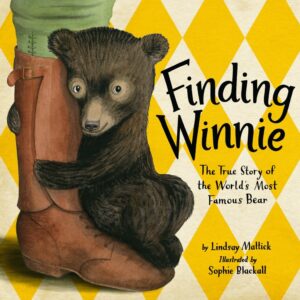 Finding Winnie: The True Story of the World’s Most Famous Bear
Finding Winnie: The True Story of the World’s Most Famous Bear
By Lindsay Mattick
Illustrated by Sophie Blackall
$18.00
ISBN: 978-0-316-32490-8
Ages 4-7
On shelves October 20th
What is it with bears and WWI? Aw, heck. Let’s expand that question a tad. What is it with adorable animals and WWI? Seems these days no matter where you turn you find a new book commemorating a noble creature’s splendor and sacrifice on the battlefields of Europe. If it’s not Midnight, A True Story of Loyalty in World War I by Mark Greenwood or Stubby the War Dog: The True Story of WWI’s Bravest Dog by Ann Bausum, it’s Voytek, the Polish munitions bear in Soldier Bear or, best known of them all, the inspiration for Winnie-the-Pooh. With the anniversary of WWI here, the children’s literary sphere has witnessed not one but two picture book biographies of Winnie, the real bear that inspired Christopher Robin Milne and, in turn, his father A.A. Milne. The first of these books was Winnie: The True Story of the Bear That Inspired Winnie-the-Pooh by Sally M. Walker. A good strong book, no bones about it. But Finding Winnie has an advantage over the Walker bio that cannot be denied. One book was researched and thought through carefully. The other? Written by one of the descendants of the veterinarian that started it all. Add in the luminous artwork of Sophie Blackall and you’ve got yourself a historical winner on your hands.
Now put yourself in Harry’s shoes. You’re suited up. You’re on a train. You’re headed to training for the Western Front where you’ll be a service vet, aiding the horses there. The last thing you should do is buy a baby bear cub at a train station, right? I suppose that was the crazy thing about Harry, though. As a vet he had the skills and the knowledge to make his plan work. And as for the bear, she was named Winnipeg (or just Winnie for short), and she instantly charmed Harry’s commanding officer and all his fellow soldiers. During training she was great for morale, and before you knew it she was off with the troop overseas. But with the threat of real combat looming, Harry had a difficult decision to make. This little bear wasn’t suited for the true horrors of war. Instead, he dropped her off at The London Zoo where she proceeded to charm adults and children alike. That was where she made the acquaintance of Christopher Robin Milne and inspired the name of the world’s most famous stuffed animal. Framed within the context of author Lindsay Mattick telling this story to her son Cole, Ms. Mattick deftly weaves a family story in with a tale some might know but few quite like this.
Right from the start I was intrigued by the book’s framing sequence. Here we have a bit of nonfiction for kids, and yet all throughout the book we’re hearing Cole interjecting his comments as his mother tells him this story. It’s a unique way of presenting what is already an interesting narrative in a particularly child-friendly manner. But why do it at all? What I kept coming back to as I read the book was how much it made the story feel like A.A. Milne’s. Anyone who has attempted to read the first Winnie-the-Pooh book to their small children will perhaps be a bit surprised by the extent to which Christopher Robin’s voice keeps popping up, adding his own color commentary to the proceedings. Cole’s voice does much the same thing, and once I realized that Mattick was playing off of Milne’s classic, other Winnie-the-Pooh callbacks caught my eye. There’s the Colonel’s surprised “Hallo” when he first meets Winnie, which struck me as a particularly Pooh-like thing to say. There are the comments between Harry’s heart and head which reminded me, anyway, of Pooh’s conversations with his stomach. They are not what I would call overt callbacks but rather like subtle little points of reference for folks who are already fans.
I was struck my Mattick’s attention to accuracy and detail too. The temptation in these sorts of books is to fill them up with fake dialogue. One might well imagine that the conversation with Cole is based on actual conversations, possibly culled together from a variety of different accounts. Since Mattick isn’t saying this-happened-like-this-on-precisely-this-date we can enjoy it for what it is. As for Harry’s tale, you only occasionally get a peek into his brain and when you do it’s in his own words, clearly taken from written accounts. Mattick does not divulge these accounts, sadly, so there’s nothing in the back of the book so useful as a Bibliography. However, that aside, the book rings true. So much so that it almost makes me doubt other accounts I’ve read.
As for the text itself, I was mildly surprised by how good the writing was. Mattick makes some choices that protect the young readers while keeping the text accurate. For example, when little Cole asks what trappers, like the one who killed Winnie’s mother, do, Lindsay’s answer is to say, “It’s what trappers don’t do. They don’t raise bears.” Hence, Harry had to buy it. She also has a nice little technique, which I alluded to earlier, where Harry’s heart and mind are at odds. The heart allows him to buy Winnie and take her overseas. The mind wins in terms of taking her to The London Zoo in the end.
I like to put myself in the place of the editor of this book. The manuscript has come in. I like it. I want to publish it. I get the thumbs up from my publisher to go ahead and then comes the part where I find an illustrator for it. I want somebody who can emote. Someone just as adept at furry baby bear cubs as they are soldiers in khaki with teeny tiny glasses. But maybe I want something more. Maybe I want an illustrator who puts in the rudimentary details, then adds their own distinctive style to the mix. I’m willing to get an artist who could potentially overshadow the narrative with visual beauty. In short, I want a Sophie Blackall.
Now I’ve heard Ms. Blackall speak on a couple occasions about the meticulous research she conducted for this book. The Canadian flag she initially mistakenly placed on a ship of war has been amended from an earlier draft (the Canadian flag wasn’t officially adopted until 1965). She researched The London Zoo for an aerial shot that includes everything from the squirrel enclosure to Winnie’s small block of concrete or stone. Blackall also includes little visual details that reward multiple readings. A scene where Harry departs on the train, surrounded by people saying goodbye, is contrasted by a later scene where he returns and far fewer people are saying hello to their loved ones. One soldier has lost a leg. Another greets his much larger son and perpetually handkerchief clutching wife. Another doesn’t appear at all. And finally, Blackall throws in beautiful two-page spreads for the sake of beauty alone. The initial endpapers show an idyllic woodland scene, presumably in Canada. Later we’ve this red sky scene of the ship proceeding across the Atlantic Ocean to Europe. For a book about WWI, that red is the closest we come (aside from the aforementioned missing leg) to an allusion to the bloody conflict happening elsewhere. It’s beautiful and frightening all at once.
In the world of children’s literature you never get a single book on the subject and then say, “There! Done! We don’t need any more!” It doesn’t matter how great a book is, there’s always room for another. And it seems to me that on the topic of Winnie the bear, friend of Christopher Robin, inspiration to a platoon, there is plenty of wiggle room. Hers is a near obscure tale that is rapidly becoming better and better known each day. I think that this pairs magnificently with Walker’s Winnie. For bear enthusiasts, Winnie enthusiasts, history lovers, and just plain old folks who like a good story. In short, for silly old bears.
On shelves October 20th.
Source: F&G sent from publisher for review.
Like This? Then Try:


By: Maryann Yin,
on 10/30/2014
Blog:
Galley Cat (Mediabistro)
(
Login to Add to MyJacketFlap)
JacketFlap tags:
Brian Floca,
Gary Kelley,
Yasmeen Ismail,
Jennifer M. Brown,
Laura Carlin,
Maria Russo,
Polly Kanevsky,
Taeeyun Yoo,
William Grill,
Awards,
Children's Books,
Sophie Blackall,
J. Patrick Lewis,
Peter Sis,
Raúl Colón,
Jerry Pinkney,
Nicola Davies,
Barbara McClintock,
Add a tag
 The New York Times Book Review has unveiled its annual list of the “10 Best Illustrated Children’s Books” of the year.
The New York Times Book Review has unveiled its annual list of the “10 Best Illustrated Children’s Books” of the year.
Shelf Awareness children’s editor Jennifer M. Brown, Caldecott Medal-winning artist Brian Floca, and Caldecott Medal recipient Jerry Pinkney sat on this year’s judging panel. See the complete list below.
Here’s more from the press release: “Since 1952, the Book Review has convened an independent panel of three judges from the world of children’s literature to select picture books on the basis of artistic merit. Each year, judges choose from among thousands of picture books for what is the only annual award of its kind. Lists of past winners of the Best Illustrated Children’s Book Award can be found on NYTimes.com/Books, along with a slide show of this year’s winners.”
(more…)
New Career Opportunities Daily: The best jobs in media.
Heather Alexander has been hired as a literary agent at Pippin Properties, Inc.
For six years, Alexander served as an editor at Dial Books for Young Readers. Some of the authors and illustrators she has worked with include Anne C. Voorhoeve, Jeanne Ryan, and Sophie Blackall.
According to the agency's email announcement, Alexander "is looking for new talent from a broad range of children’s book authors and illustrators, from picture books through young adult, including graphic novels. She’s most interested in unique characters, strong voices, and quirky humor."
New Career Opportunities Daily: The best jobs in media.
The Baby Tree
By Sophie Blackall
The question comes soon or late for young parents: “Where do babies come from?” A new sibling on the way can prompt it or right now in springtime, it seems that new life is visible everywhere and that may just be the impetus for the query. Baby rabbits can be seen munching on clover on our lawn and a young groundhog that we named Geoffrey has been seen of late surreptitiously snacking on our newly planted lettuce leaves. Where did he come from? Well, Sophie Blackall of Pecan Pie Baby fame that deals with new baby/sibling issues, has the answer in her new book, The Baby Tree. Here, Ms. Blackall’s curious small boy tracks down a variety of charmingly sweet answers to his question in a round about trip that ends, as it should, with Mom and Dad’s explanation. Initially, he finds his answer provided from a variety of people. And he receives a variety of responses.
Mom and Dad announce at breakfast the “BIG NEWS”. A new baby is coming and that of course prompts the question. “Where are we going to get the baby?” Cue for both Mom and Dad to fly out the door as they are both running late! Or maybe they are both just plain running, as there doesn’t seem to ever be a convenient time for THE QUESTION to be tackled. Enter right on time, Olive, the baby sitter who sweetly relates the planting of a seed that results in a “Baby Tree”. Teenagers, you have to admire their efforts that are sometimes a mixture of half-truths, but always eager to help with their version of the story.
In close succession, follows a number of variations on the answer to a theme. From his teacher, Mrs. McClure, comes the succinct answer: the hospital. To the point, Mrs. McClure, but it misses the larger “baby in the room” question! But I do like her approach. She listened to the question and gave the answer that was, in fact, correct. Grandpa uses the tried and true; “A stork brings your baby in the night and leaves it in a bundle on your doorstep.” That sounds fanciful enough, but daily doorstep checks yield no results for the small boy. And the mailman is a tad closer to the truth as he ventures the opinion that babies come from eggs, but “he doesn’t know where to get the eggs.” Quick thinking, Mr. Mailman!
Ms. Blackall’s art gives full reign to the pictured imaginings of each of the answers to the small boy’s question. They are just what a child might come up with in his mind’s eye. Confusion reigns supreme and it is time for a bedtime story followed by a SECOND bedtime story that relates the true story of “Where do babies come from?”
Sometimes, we parents tend to overthink these things and give way more complex answers to the question that is being asked by our children. I’ve learned as a parent that more often we need to listen closely to the question and answer only what is asked at the time, and over time, more details may be added to our initial response. Information overload can be a problem.
Ms. Blackall’s The Baby Tree gives just enough, using proper reproductive terminology in a non-babyish way that explains the miracle of birth. And at the end of the book, she gives helpful hints on answering additional questions that may emanate from the first.
Okay, now WHO is going to sit with Grandpa and set HIM straight on this stork story? Why his grandson, of course! Well done, Ms. Blackall.

By: Carter Higgins,
on 5/27/2014
Blog:
Design of the Picture Book
(
Login to Add to MyJacketFlap)
JacketFlap tags:
design,
space,
book trailer,
concept,
rhythm,
giveaway,
scale,
penguin,
trailers,
sophie blackall,
composition,
spot illustrations,
white space,
proportion,
nancy paulsen books,
full bleed,
the baby tree,
Add a tag
 by Sophie Blackall
by Sophie Blackall
published 2014 by Nancy Paulsen Books, at Penguin Kids About a year ago, I heard Sophie Blackall give a keynote at SCBWI Western Washington. She wears great tights and shoes and is a total riot. She had this effervescent spirit that had the whole room in stitches. It felt like watching one of her illustrations bounce right off the page and into the room.
About a year ago, I heard Sophie Blackall give a keynote at SCBWI Western Washington. She wears great tights and shoes and is a total riot. She had this effervescent spirit that had the whole room in stitches. It felt like watching one of her illustrations bounce right off the page and into the room.
See, I’m a big fan. Ivy and Bean are soul sisters. I gushed about The Crows of Pearblossom and The Mighty Lalouche over at Design Mom, and still stand by this tweet from the end of 2013.
Her work has sprinkles of fairy dust or something in it – something enchanting and mysterious and compelling and darn beautiful.
And this, her latest offering, is both calming and humorous, sweet and sassy. It’s a bound and beautiful answer to the dreaded where do babies come from?
 She’s so in tune with the vast (and sometimes creepy!) imagination of a youngster, and look at how that plays out in this art. Real life is a spot illustration, surrounded by white space and unknowns. But the what if bleeds to the edge of the page, filling every millimeter with color and wonder and possibility. Not only is it stunning to see, it’s intentional storytelling.
She’s so in tune with the vast (and sometimes creepy!) imagination of a youngster, and look at how that plays out in this art. Real life is a spot illustration, surrounded by white space and unknowns. But the what if bleeds to the edge of the page, filling every millimeter with color and wonder and possibility. Not only is it stunning to see, it’s intentional storytelling.
 Hat tip, always, to Jules at Seven Impossible Things Before Breakfast for the interview that revealed that delicious tidbit. Check out her interview (and more art!) with Sophie here.
Hat tip, always, to Jules at Seven Impossible Things Before Breakfast for the interview that revealed that delicious tidbit. Check out her interview (and more art!) with Sophie here.
Sophie works in Brooklyn with other illustrators Brian Floca, Ed Hemingway, John Bemelmans Marciano, and Sergio Ruzzier. Can you even imagine spending an hour in that studio, soaking it all up and trying not to faint and fall in it? Dream field trip, for sure. Their kinship and support of one another has always been so apparent. Look here, and here, and here to see what I mean.
But also, look inside The Baby Tree for a glimpse at their love and support of one another. What’s our pajama-clad wonderer reading with Mom and Dad, all cozied up in bed? I won’t spoil it for you, cause it was a gasp-moment for me. If you’ll bust without knowing, check out Danielle’s post over at This Picture Book Life about allusions in picture books. (And stay there a while even once you see what I’m talking about, cause how brilliant is that?!)
You’d like a copy, right? Penguin has two to give away to you! (And you!) Just leave a comment on this post by Monday at noon PST, June 2nd. I’ll pick two, and have the stork deliver The Baby Tree right to your doorstep. Good luck!

Review copy provided by the publisher, all thoughts and love my own.
Tagged:
book trailer,
composition,
full bleed,
giveaway,
nancy paulsen books,
penguin,
sophie blackall,
spot illustrations,
the baby tree,
white space 
Book: The Baby Tree
Author: Sophie Blackall
Pages: 40
Age Range: 4-8

 The Baby Tree by Sophie Blackall is a very well-done picture book about a boy's quest to understand where babies come from. After a boy's parents tell him that a new baby will be joining their family, he asks various people in his life if they can tell him where babies come from. They give him answers like "you plant a seed and it grows into a baby tree" and "a stork brings your baby in the night." Finally, when the boy is thoroughly confused, his parents explain it to him properly. The explanation is age appropriate in level of detail and content, I thought: "a seed from their dad ... planted in an egg inside their mom", etc. An afterword suggests sample text for answering other questions that kids may have. That text mentions body parts by name, but this terminology is not in the main text.
The Baby Tree by Sophie Blackall is a very well-done picture book about a boy's quest to understand where babies come from. After a boy's parents tell him that a new baby will be joining their family, he asks various people in his life if they can tell him where babies come from. They give him answers like "you plant a seed and it grows into a baby tree" and "a stork brings your baby in the night." Finally, when the boy is thoroughly confused, his parents explain it to him properly. The explanation is age appropriate in level of detail and content, I thought: "a seed from their dad ... planted in an egg inside their mom", etc. An afterword suggests sample text for answering other questions that kids may have. That text mentions body parts by name, but this terminology is not in the main text.
This book does so many things right. First of all, the illustrations are hilarious. The "baby tree" is shown on the cover. Even better is a picture of a hospital chock-full of babies, with a line of swaddled babies (basically heads atop blankets) somehow upright and making their way out the front door. Other aspects of the illustrations are more subtle, but also pleasing. The babies are a multi-cultural rainbow, also bearing a diverse assortment of blankets. The expressions on the faces of the people the boy asks about babies are priceless. The mailman looks positively sheepish as he scratches his head and says something about eggs. (And oh, the baby face peeking out of a bird's egg is adorable.)
The other thing that I like about this book is that even though it's about something (where babies come from), there are lots of other details that are simply true to the life of a preschooler. I know that my daughter is going to laugh when she reads about the boy waking up Dad, then eventually waking up Dad again. And she'll relate to when the boy uses his parents' excitement about the baby to finagle a second bowl of cocopops. Kids have priorities, you know. There are a few tidbits in here for parents, too, as when the teacher gives the briefest possible answer to the boy's question, and then immediately says: "Boys and girls, it's time to wash our brushes." The adult reader can practically hear her thinking: "Because I don't want to get into this discussion here at school."
The fact that the boy's parents tell him their news at a time when they have to rush off, leaving him to ask all of these other people, is a tiny bit contrived. But I will cheerfully forgive Sophie Blackall for that. Because this book is wonderful. In the end, it answers children's questions about where babies come from, simply and honestly. But along the way, it provides delightful, whimsical pictures set against realistic depictions of the life of a preschooler. This is a must-purchase for parents expecting another baby, and for libraries. Highly recommended.
Publisher: Nancy Paulsen Books (@PenguinKids)
Publication Date: May 1, 2014
Source of Book: Review copy from the publisher
FTC Required Disclosure:
This site is an Amazon affiliate, and purchases made through Amazon links (including linked book covers) may result in my receiving a small commission (at no additional cost to you).
© 2014 by Jennifer Robinson of Jen Robinson's Book Page. All rights reserved. You can also follow me @JensBookPage or at my Growing Bookworms page on Facebook.

By:
Bianca Schulze,
on 4/29/2014
Blog:
The Children's Book Review
(
Login to Add to MyJacketFlap)
JacketFlap tags:
Mo willems,
Ages 0-3,
Ages 4-8,
Ages 9-12,
Garth Williams,
Book Lists,
Series Books,
Kids Series,
featured,
Sophie Blackall,
Annie Barrows,
Anne Wilsdorf,
Knuffle Bunny,
Ivy + Bean,
E. B. White,
Christopher Healy,
Best Kids Stories,
Series List,
Add a tag
My list of family favorites is skewed toward books or series my wife and I have been able to share and enjoy with our two daughters (ages 9 and 6). We have many other favorites, but unlike the characters in my own books, I’m a notorious rule follower. So here are just five that have had the biggest impact so far.

Have you heard of Skillshare? Virtual, project-based learning on a whole slew of subjects. I still have a Digital Illustration course I have yet to finish! Or start, for that matter. And that’s the beauty of Skillshare, that I can smoosh it into my schedule when there’s some free time. (Anyone have some to donate?!)
Illustrator Annie Patterson is teaching a course called Children’s Book Illustration: From Sketch to Final Art, and the image above is the illustration she demonstrates in the course.
If you’re interested, Annie graciously shared a discount code for $10 off the original course price of $25. You can use the code DRAWING, which is available through October 5th.
Have fun! How cool is this tweet:
How cool is this tweet:
I shared Sophie and Matthew Olshan’s The Mighty Lalouche over at Design Mom this week. There’s a pop-up version of the Unofficial Sophie Blackall Fan Club over there. And Matthew chimed in, too! My reader heart swoons.
And then I shared this snippet of why I identify with Lalouche:
Here’s where art meets life. Next week (!) I start a new job as a librarian at an elementary school. It’s been a bunch of years since I’ve done that, and I’m thrilled to bits.
In this book, Lalouche loves his simple life as a postman. Leaves for boxing fame and fortune, but (spoiler!) returns to his roots cause he just loved his postman days so, so much.
My story feels similar. I am Lalouche today!
Happy weekend! (I guess I should remove former from that bio up there! PINCH ME.)

Tagged:
matthew olshan,
skillshare,
sophie blackall,
the mighty lalouche 

By: Joy Chu,
on 6/11/2013
Blog:
got story countdown
(
Login to Add to MyJacketFlap)
JacketFlap tags:
Tove Jansson,
Moomin,
Kevin Henkes,
Sophie Blackall,
diorama,
Jules,
Barbara McClintock,
Julie Danielson,
illustration classes,
Real life stories about illustrators,
taught by Joy Chu,
teaching children's book illustration,
UCSD Illustrating Children's Books Workshop with Joy Chu,
More adventures in teaching,
Timeless themes for picture books,
Zachariah Ohora,
"Chalk" by Bill Thompson,
"Kitten's First Full Moon",
2ummer 2013 UCSD Extension class taught by Joy Chu,
advent-style calendar,
Aijung Kim,
China circa 1909,
CIP data,
creating 3D models for picture book,
Fnu Anisi,
Library-of-Congress Cataloging in Publication Data,
one-phrase book summary,
studies for "Adele and Simon in China",
UCSD Extension ART 40011 class,
Add a tag
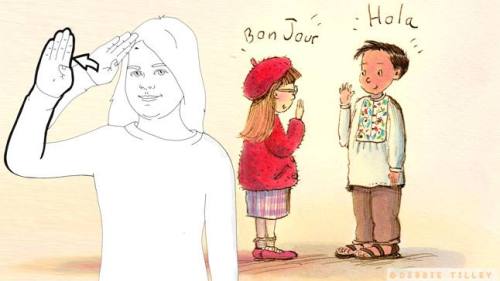
Greetings! If you live, work, or are vacationing this summer in the San Diego area, consider creating stories with pictures at my class, on the beautiful campus of UCSD in La Jolla!
Illustrating Books for Children
Instructor: Joy Chu
June 26-August 21
Wednesday evenings, 6:30pm-9:30pm
extension.ucsd.edu
Register before June 25!
 _________________________
_________________________
Inspiration is Everywhere!
During last winter’s 2013 class at UCSD Extension, I asked my students to locate the CIP book summary from any picture book, and use it as the inspiration for an eight-panel wordless picture story.
CIP (“pronounced “sip”) is book publishing jargon for the Library of Congress Publishing Cataloging-in-Publication Data. This is found within the copyright page text of every book. It features a well-constructed one-phrase synopsis of the book’s theme.
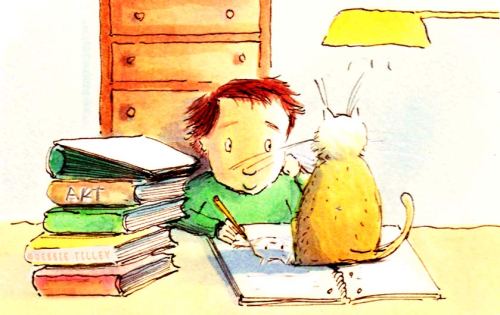
Here is an example. One student, Aijung Kim, selected the following CIP summary from Chalk by Bill Thompson. While she didn’t read the book, she knew from its cover that it featured a dinosaur. . .

“Book Summary: A wordless picture book about three children who go to a park on a rainy day, find some chalk, and draw pictures that come to life.”
Here’s what she came up with:
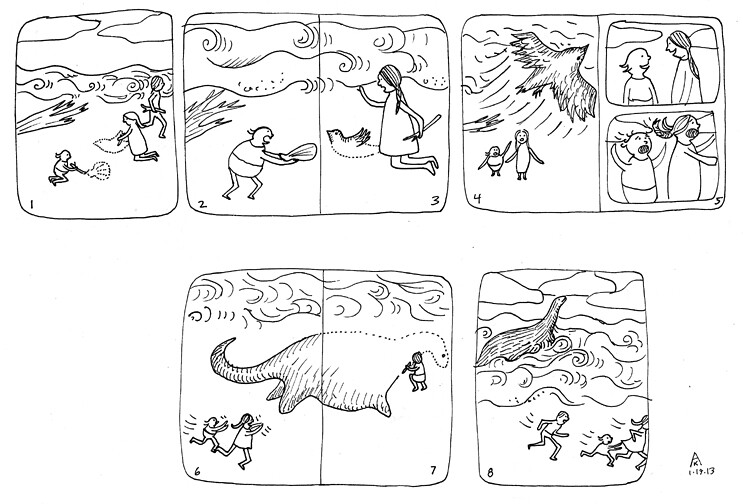
Aijung Kim’s 8-panel wordless story, created during Joy Chu’s class, Illustrating Books for Children, at UCSD Extension (right-click image to enlarge)
Another student, Fnu Anisi, enchanted by Kevin Henkes‘ Kitten’s First Full Moon, wanted to explore an eight page wordless re-telling.

Book summary: When Kitten mistakes the full moon for a bowl of milk, she ends up tired, wet, and hungry trying to reach it.
Here are Anisi’s results:
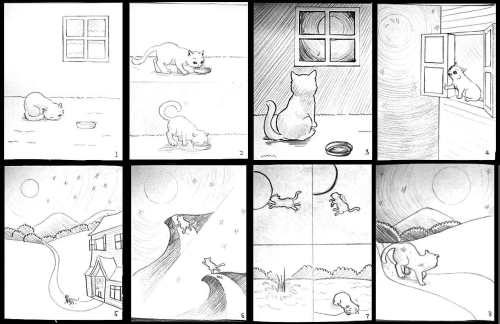
Fnu Anisi’s 8-page wordless story, created at Joy Chu’s UCSD Extension class (Right-click to enlarge)
At my upcoming summer 2013 UCSD Extension class (June 26-August 21), Illustrating Books for Children (ART 40011) we might look into creating an advent-styled calendar as a possible inspiration for creating a picture story.
Example: Look at the one Zachariah OHora created from his own story. Fun, yes?
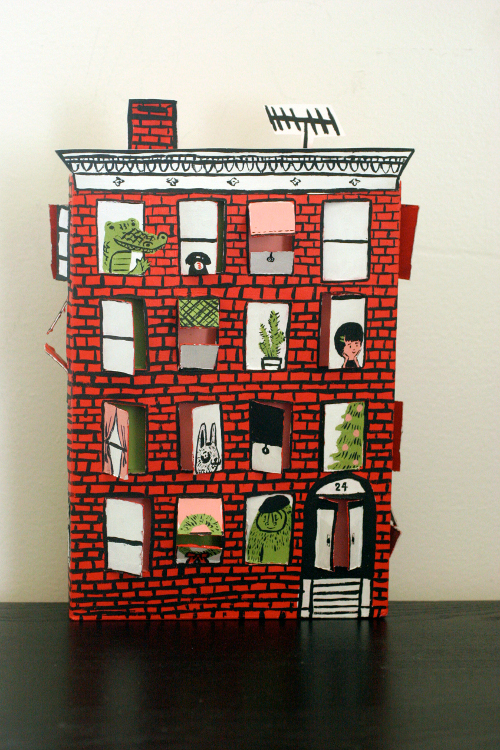
Many thanks to Zachariah OHora and Julie Danielson for sharing the above image.
Creating a 3D model for your story setting can also serve as an invaluable reference in plotting out your narrative, as well as a guide in drawing scenes from a variety of perspectives. Note how illustrator Sophie Blackall created a diorama for her work-in-progress. She can view her characters from above!

(photo © PWxyz, LLC. All rights reserved)
Author/illustrator Barbara McClintock builds cut-paper replicas of her illustrations, in composing her scenes. The following sequence is from her studies for an upcoming book, Adèle and Simon in China (all 3 photos below © Barbara McClintock)
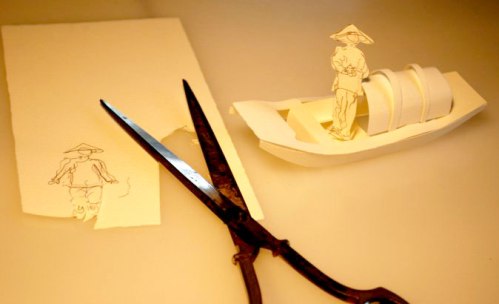
“What do those little flat boats in photos of Tongli really look like? I have to find out by building one.”—Barbara McClintock

“…Now I can draw the boats in the picture and feel some sense of confidence in what I’m doing/seeing…”
Here’s Tove Jansson, creating reference models for her fabulous Moomin stories.

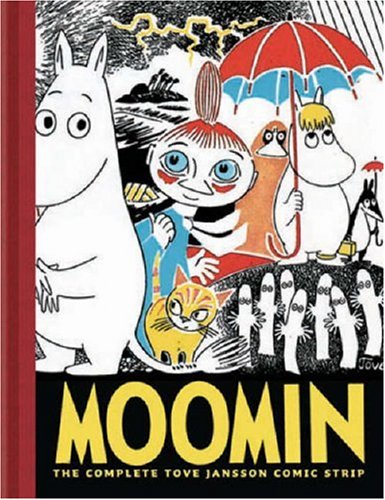
____________________
Illustrating Books for Children / Art 40011
June 26-August 21
Wednesdays, 6:30pm-9:30pm
extension.ucsd.edu
Register before June 25!



By: Maryann Yin,
on 4/3/2013
Blog:
Galley Cat (Mediabistro)
(
Login to Add to MyJacketFlap)
JacketFlap tags:
Children's Books,
Poetry,
Authors,
Jane Yolen,
Sophie Blackall,
J. Patrick Lewis,
National Poetry Month,
Michael Slack,
Anne Schwartz,
Add a tag
 Happy National Poetry Month! All throughout April, we will interview poets about working in this digital age. Recently, we spoke with J. Patrick Lewis, the United States’ current children’s poet laureate.
Happy National Poetry Month! All throughout April, we will interview poets about working in this digital age. Recently, we spoke with J. Patrick Lewis, the United States’ current children’s poet laureate.
Lewis (pictured, via) worked as an economics professor for many years. The sighting of a moonbow (a white rainbow) inspired him to write his first children’s story.
He has since gone on to write more than eighty books and has collaborated with other respected members of the industry including prolific children’s writer Jane Yolen, illustrator Sophie Blackall, and artist Michael Slack.
continued…
New Career Opportunities Daily: The best jobs in media.
By Bianca Schulze, The Children’s Book Review
Published: September 3, 2012
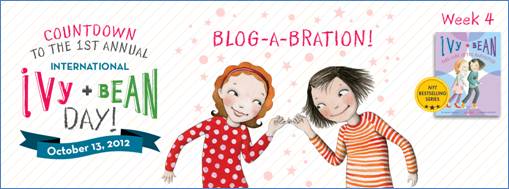
Join the 9 week “Countdown to Ivy and Bean Blog-A-Bration!”
Each week, you can enter to win the weekly featured paperback Ivy and Bean book and 3 sets of Ivy and Bean Mini Notes. During week 9 a Grand Prize Winner will be chosen from all of the previous winners* to receive:
Giveaway begins September 3, 2012, at 12:01 A.M. PST and ends September 8, 2012, at 11:59 P.M. PST.
Reading level: Ages 6-10
Paperback: 124 pages
Week 3
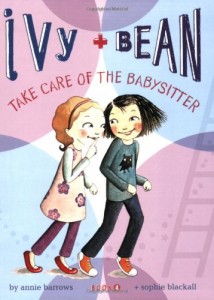 Ivy and Bean Take Care of the Babysitter. The adventures of Ivy and Bean continue in the latest installment from series creators Annie Barrows and Sophie Blackall. In Ivy and Bean Take Care of the Babysitter, the two girls hatch a plan to prove that Bean’s big sister is the world’s worst babysitter. Of course plans go awry, but fun ensues!
Ivy and Bean Take Care of the Babysitter. The adventures of Ivy and Bean continue in the latest installment from series creators Annie Barrows and Sophie Blackall. In Ivy and Bean Take Care of the Babysitter, the two girls hatch a plan to prove that Bean’s big sister is the world’s worst babysitter. Of course plans go awry, but fun ensues!
About the Author
Annie Barrows is the author of many books for adults, including the bestselling The Guernsey Literary and Potato Peel Pie Society, but Ivy and Bean is her first series for kids. She lives in Northern California with her husband and two daughters.
Visit: http://www.anniebarrows.com/
About the Illustrator
Sophie Blackall is an Australian illustrator whose previous books include Ruby’s Wish and Meet Wild Boars. She lives in Brooklyn, New York.
Visit: http://www.sophieblackall.com/
How to Enter
- Fill out the required fields below
Giveaway Rules
- Shipping Guidelines: This book giveaway is open to participants with a United States or Canadian address.
- Giveaway begins September 3, 2012, at 12:01 A.M. PST and ends September 8, 2012, at 11:59 P.M. PST, when all entries must be received. No purchase necessary. See official rules for details. View our privacy policy.
- The Grand Prize Winner will be selected by Chronicle Books and will be chosen from all of the previous winners from the following websites that are participating in the blog-a-bration:
Prizing courtesy of Chronicle Books.
Original article: Giveaway: Ivy and Bean, Week 4
©2012 The Childrens Book Review. All Rights Reserved.
View Next 24 Posts


























 The New York Times Book Review has unveiled its annual list of the “
The New York Times Book Review has unveiled its annual list of the “









 _________________________
_________________________








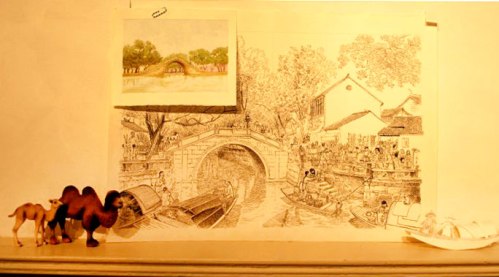


 Happy National Poetry Month! All throughout April, we will interview poets about working in this digital age. Recently, we spoke with J. Patrick Lewis, the United States’
Happy National Poetry Month! All throughout April, we will interview poets about working in this digital age. Recently, we spoke with J. Patrick Lewis, the United States’ 
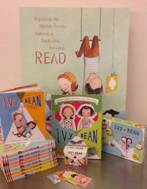

I can’t wait for this one. Super cute cover too!
My kids (and I) will love this. We want it … now!
Hurray for you! Can’t wait to read it.
Congrats!
Looks great! Congrats.
This looks terrific. Congrats, Betsy!
So excited!
Now please go make 10 more.
kthxbai 😉
Pre-ordered. Way to go!
What a great idea. Thanks for editing such a terrific selection.
Wow! This looks terrific! Congratulations!
YES! I want one, too! Heading over to pre-order… whoosh.
I will be adding this to my collection. We really need some funny, as we Canadians peer over the border, nervously watching our American neighbo(u)rs go to the polls.
This book looks and sounds amazing. I cannot wait to read it and share it with my students.
Love the idea! Love the cover! Love the line-up of authors! HATE the pub. date! ;-(
Yep, I’ll pre-order it now.
Congratulations to all!
I’m laughing already! Congratulations, Betsy! -Feelin’ free and will order
AWESOME cover, and heartiest mazel tovs!!!!! cannot WAIT to read. (i just typed “cannot wait to rad.” i am sure it is that.)
Considering all the latest “developments,” can you please, please move up the publication date? (I can solicit Pigeon’s help on pleading, if it’ll help.)
I like the way you think.
Awesome sauce! Can’t wait to read this.
Congratulations, Betsy! Looks delightful!